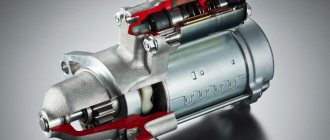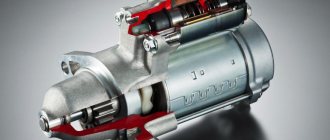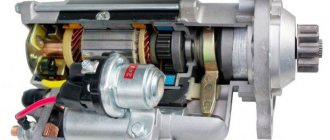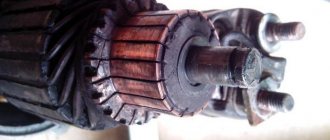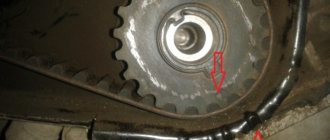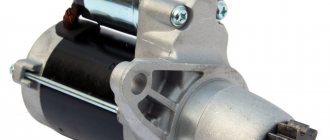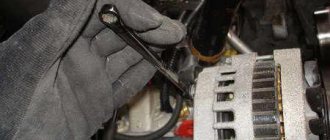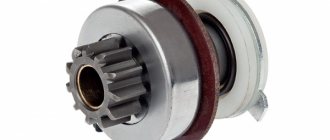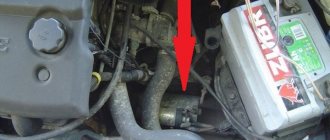If you are a car owner, then you will be interested in knowing why the starter turns but does not engage the flywheel.
This problem, unfortunately, is not so rare, especially for older cars. If many years ago drivers had not even heard of a starter, since the engine was started using a handle, today this device is a mandatory component of any engine. Now you don’t need to get out of the car to start the engine; just insert the ignition key into the lock to turn on this device, or use a special button. We will tell everyone why the starter turns but does not engage the flywheel, since the principle of operation of this unit is the same for all such devices, regardless of the car model or manufacturer. Among the many diseases of this device, today we will highlight and consider in more detail one, these are the problems of the overrunning clutch, or as drivers also call it, Bendix. In this case, the starting device itself has no problems, but it is the clutch that fails.
Starting system for a modern car
Today, motorists have a much easier time than several decades ago, when the car was started with a crank. In those days, one could only dream of starting the engine from inside the car.
Nowadays, it is enough to insert the key into the ignition or press a special button for the car to start. But problems also occur in this case, if the nodes, so to speak, “get sick.” No matter how modern a car is, over time it becomes outdated, and more and more problems arise.
One of them just implies poor engagement of the flywheel by the starter. Why does this happen? Experts, as soon as the topic comes up, mention the problem of the overrunning clutch or bendix.
Purpose of Bendix in a car
Bendix
Overrunning clutch is a gear mechanism capable of transmitting anchor rotation to the engine flywheel. Thus, the engine starts.
Attention. A prerequisite for trouble-free operation of the components of the automotive system is the removal of the bendix after the engine has been successfully started.
You should know that a clutch is not just a gear, but a mechanism that also develops malfunctions.
To more fully understand the cause of the problem with the flywheel engaging, it will be useful to consider the general principle of operation of the entire starting system.
The starter is a DC electric motor. In some cases, it develops much more power than required. Thus, it becomes possible to run the internal combustion engine with maximum displacement.
In a modern starter, an important role is played by a relay - a special unit that brings the clutch into contact with the flywheel some time before the armature false start. Then only voltage is applied to the starter winding, after which it begins to rotate the crankshaft of the car engine.
The rotation of the crankshaft becomes a source of compression of the combustible mixture, followed by its ignition. As soon as this happens at the right moment, the internal combustion engine begins to function automatically.
At this very moment, the metonymic cycle of the flywheel begins to dominate the revolutions of the starter shaft (armature), and the bendix is already engaged. As soon as the driver turns off the car, the starter shaft no longer rotates, and the traction drive disengages the clutch.
It is important to understand that the bendix itself consists of 2 parts: upper and lower (HFB and LFB). The latter acts in the form of a hollow shaft having two different calibers. One of the parts of the shaft is equipped with splines that transmit rotation of the starter, and the other part contains a cage with rollers.
Videos in analysis
There is no interaction between the videos and the NCB initially. It occurs only after, when the first revolutions appear. The rollers are brought to the middle, thereby limiting the shaft. This happens in such a way that the shaft can only rotate in one direction. The rollers, thanks to their springs, do not allow them to rotate in the other direction.
Once the flywheel gains speed, it will be able to rotate the bendix. In this case, the rollers move apart, opening the stopper. The gear mechanism returns to its primary position.
Bendix often freezes in the mornings when it is cold. Experienced drivers recommend cranking the starter several times, thereby heating the bendix and enabling its operation.
Price issue
Finally, it’s worth adding that Bendix is an inexpensive spare part. For example, a Bendix VAZ 2101 (as well as other “classic” VAZs) costs about $5...6, catalog number is DR001C3. And the price of Bendix (no. 1006209923) for VAZ 2108-2110 cars is $12...15. The cost of Bendix for FORD cars of the Focus, Fiesta and Fusion brands is about 10...11 $. (cat. no. 1006209804). For TOYOTA Avensis and Corolla cars Bendix 1006209695 - $9...12.
Thus, repairs are often impractical for Bendix. It's easier to buy a new one and simply replace it. Moreover, when repairing individual parts, there is a high probability of rapid failure of others.
A starter is an electromechanical device that starts the engine by creating primary torque of the crankshaft at the required speed to create a compression ratio to ignite the combustible mixture.
And when the starter does not work or works intermittently, starting the engine is very problematic and sometimes impossible. But before you start looking for the reasons why the starter does not turn, you need to remember that this unit works in tandem with other systems
vehicle in the common starting-charging circuit (battery-starting control mechanism-starter). Therefore, there can be both mechanical and electrical breakdowns, which have their own distinctive features.
Inoperability
Not the starter, but the bendix does not engage the flywheel. This is how you need to understand the problem. Let's look at the reasons why this might happen.
- If the mechanism does not lock on the starter shaft. This is often caused by the fact that over time, the rollers with springs wear out and are no longer able to provide reliable engagement.
- Hardening of the grease is also a common cause of this problem. It simply turns into a thick lump, limiting the movement of the Bendix roller-spring system. As a result of this, no engagement occurs. A common cause of grease hardening is dirt or dust getting inside the starter.
- It is also possible that the bendix teeth or flywheel ring are worn out. In this case, there will also be no engagement. If the problem is in the crown, then it is simply replaced with a new one. The same is done with Bendix, which is being updated.
Attention. In some situations, if the cause of the Bendix malfunction is contamination, thorough cleaning of the device helps. On the other hand, experts do not recommend using a repaired Bendix. It's better to install a new one right away.
It will be useful to know that some types of starters are equipped with a plastic Bendix drive. This means that such a product breaks easily, and starting the internal combustion engine becomes impossible.
Self-repair of Bendix starter
Many motorists do not think about how to change the Bendix on the starter, but prefer to repair it. In many cases, repairing the starter bendix is quite possible by replacing the rollers or thoroughly cleaning the armature shaft and the inside of the overrunning clutch. Repairing the Bendix starter yourself will save money on purchasing a new unit, and in some cases significantly reduces the repair time.
To repair the Bendix starter you need to:
- Remove the starter from the car by disconnecting the wires from the solenoid relay;
- Disassemble it by carefully disconnecting the wire from the retractor;
- Remove the overrunning clutch and clean it outside;
Inspect it carefully and make sure that repairing the starter bendix is possible.
If there are no cracks in the housing, you can begin directly repairing the starter Bendix. First, you can place the dismantled unit in a container with gasoline for several hours, turning it periodically. In some cases, this procedure will be the repair of the overrunning clutch. Repairing the Bendix starter here comes down to dissolving internal deposits and returning the rollers to mobility without replacing them. If the fault is not resolved, repair work will be more labor-intensive.
We begin repairing the Bendix starter by disassembling its housing. Having gained access to the rollers and springs, you need to remove them and thoroughly clean them. As a rule, rollers are little subject to wear and do not need to be replaced or repaired. The malfunction is very often hidden in resinous deposits, and repairs come down to removing them. In this case, the Bendix starter repair will consist of:
- Cleaning hard internal deposits inside;
- Flushing the housings in gasoline.
Next, you need to carefully inspect the inside of the coupling housing, and if there is no damage, you can put it back together. After making sure that the rollers are not damaged, they are installed in their original place. If the rollers are not cylindrical, you will have to replace them with new ones.
Repair rollers are installed with a slightly larger diameter. You cannot replace individual worn-out rollers - the entire set requires replacement. After installing the rollers, springs are installed and the entire body is assembled. After assembly, it is necessary to check the results of the repair - the gear should rotate in only one direction.
We install the assembled device on the armature shaft and secure it with a retaining ring. The question of how to lubricate the starter Bendix can be answered unequivocally - nothing. The repair of the Bendix starter consisted of removing coked oil and applying any lubricant is unacceptable. Next, the starter is assembled and cleaned before installing the retractor relay and mounted on the car. After completing the repair work and replacing individual parts, we check the starter on the car. Before the first start-up, it is necessary to check the correct fastening of the solenoid relay wires. If the armature rotates freely and there is clear engagement with the flywheel, then the repair has been completed correctly.
As you can see, repairing a Bendix starter is a task quite feasible for many drivers. Replacing individual parts and complex disassembly is often not necessary and all actions are reduced to washing the unit. Self-repair allows you to avoid replacing expensive units and save considerable money.
It twists and doesn’t catch - what’s the reason?
A variety of factors prevent the starter from working correctly.
For example, this device usually causes a problem in winter because the engine oil thickens and the starter does not have enough power to turn the crankshaft.
However, if the starter turns idle, but does not catch, there are 5 main reasons.
- flywheel teeth wear out and no longer engage with the bendix;
- fork - breaks;
- the starter gear is warped and changes its position;
- power supply - wear of the solenoid relay, bushings or other parts of the starter;
- compression - absent or too low.
All this requires more detailed consideration.
Replacing the starter bendix
To change the bendix, the starter must be removed and disassembled. On different car models, removing the starter may be accompanied by certain difficulties and nuances. After removing the starter, it is necessary to disassemble the housing to check/repair/replace the bendix;
Before you start checking and/or replacing the overrunning clutch, it is important to understand what a starter bendix is in general and how this solution works. If the bendix has not been removed previously, but signs of its malfunction have been identified, you can immediately buy a starter bendix and begin replacing
However, experienced specialists recommend first removing the starter and checking the existing bendix, since the reason is not always there. In any case, before starting work, you need to learn in advance how to change the bendix on the starter.
The general steps are as follows:
- unscrew the tightening bolts and open the housing;
- Unscrew the bolts securing the solenoid relay;
- remove the bendix from the axle by removing the washer and removing the restrictive ring;
- carefully remove dirt and deposits on internal elements and surfaces;
- Before installing a new/repaired Bendix, the axle must be lubricated with high-temperature grease
- We install the locking ring and washer (the procedure is complicated, the ring needs to be opened using an open-end wrench, a clamp, pliers, etc.).
- after installing the Bendix, the rubbing parts of the starter must be lubricated with high-temperature lubricant (do not allow excess to get on the parts);
The final step before installing the starter on the car is to check it. To do this, supply power directly from the battery to the starter. Using a wire, “+” is connected to the control contact of the starter solenoid relay, “-” is connected to the starter housing.
Normally, you should hear a click when connecting, and the bendix moves forward. If the bendix does not extend, it is necessary to check and replace the solenoid relay.
Flywheel teeth
The flywheel wears out over time. The fastest thing to deteriorate is the crown that clings to the starter. Improper handling of the ignition key causes its teeth to grind down. This also happens due to constant loads.
In this state, the starter gear or overrunning clutch rotates idle, without clinging to the flywheel.
The flywheel teeth can be tested without dismantling the starter. Here's what to do:
- set the third or fourth speed;
- push the car half a meter forward - with the efforts of several people;
- try to restart the engine.
If the car starts, the crown will have to be replaced. This confirms the wear of any tooth. It is also possible that the teeth have worn off all over the circle, but this rarely happens.
Wear of flywheel ring teeth
How to remove bendix
First you need to dismantle the starting device itself, having first disconnected the positive terminal from the battery, and from the starter - the wire going to the solenoid relay. Removing the starting device (most often it is fixed with three bolts) is possible from the top or bottom (you will need an inspection hole) - it all depends on the make of the car. At the same time, inspect the flywheel teeth: if they are very worn, you will have to replace the ring gear or the entire flywheel. After the starter is on the workbench, dismantle (if necessary, here everything again depends on the model of the machine) the solenoid relay. Next comes the removal of the bendix:
- Unscrew the nuts securing the vertical studs (usually there are three of them) and, lightly tapping with a rubber mallet, separate the starter housing. Take this opportunity to visually assess the condition of the brushes and windings.
- Hook the bendix by the “ears” with a flat-head screwdriver and pull it out of the fork.
- Take a hammer and an open-end wrench that fits the diameter of the overrunning clutch shaft and remove the first retaining ring; the second can be moved with a flat-head screwdriver.
- Now we remove the starter bendix itself.
Article on the topic: How to melt the ice in the washer fluid reservoir
Fork failure
The starter fork is a special lever made of plastic or metal material. Participates in the transmission of force from the solenoid relay to the starter. Failure of this part makes it impossible to start the engine, since the overrunning clutch does not extend.
Frequent reasons why the plug breaks:
- wear of fastening parts - the situation is especially difficult with a plastic fork, since ground pins can be impossible to weld and the entire element has to be replaced;
- overheating of the starter - due to jamming of the overrunning clutch or faulty contacts, the starter does not turn off after starting the engine and breaks the plug;
- overexposing the ignition key has the same result, but the part is already damaged due to the human factor.
Broken starter fork
It is noteworthy that on modern cars, which have excellent sound insulation, starter forks break more often. Why? The fact is that the driver simply does not notice the engine starting and continues to turn the key.
How to replace the overrunning clutch?
To replace the clutch, you will need to remove the starter and disassemble it. Each brand of vehicle has certain nuances. Let's look at the sequence of work immediately after dismantling the starter. To replace the clutch, you will need to disassemble the starter housing:
To open the case, you need to unscrew the fasteners. Bolts are used to tighten the body; then you need to unscrew the fasteners holding the overrunning clutch. During disassembly, it is recommended to clean all parts from dirt; The overrunning clutch must be removed from the axle. To do this, you will need to knock down the washer, and then use a screwdriver to remove the ring; a new coupling is installed. It is recommended to apply a moderate amount of temperature lubricant first; Car owners usually experience difficulties during the installation of the washer and retaining ring. Therefore, to carry out the work you will need to prepare a number of tools, for example, clamps. Some motorists use sliding pliers, open-end wrenches and other improvised means for this; After installing the overrunning clutch, a lubricant must be applied to all rubbing elements
It is recommended to pay attention to the fact that the lubricant must be high-temperature. Also, you should not apply a large amount of lubricant, as this will complicate the performance of individual elements; Before installing the Bendix, you need to check the functionality of the starter
For these purposes, you can use any wires or a cigarette lighter. A positive charge must be applied to the retractor contacts. The minus is connected directly to the starter housing. If the mechanism is working, a characteristic click will occur when the wire is connected. In this case, the bendix should move forward. If this does not happen, then the breakdown may lie in the solenoid relay.
A few recommendations from experienced car owners
During the process of replacement or repair work, it is possible that a number of problems may arise. To avoid them, you should adhere to the following recommendations:
before installing a new overrunning clutch or repairing a part, it is necessary to check its functionality. It is also extremely important to check the starter; During the repair process, it is necessary to pay attention to consumables. The washers must not have visible damage; when purchasing a new overrunning clutch, it is recommended to have the old part with you. Elements may be almost identical in appearance, but have minor differences; if dismantling the starter and bendix is carried out for the first time, then it is recommended to record all stages of work
Recording can be done using familiar storage media such as paper. Alternatively, you can record the disassembly process on video.
Video instructions: installation and repair of a Bendix starter
The presented video material will allow you to familiarize yourself with the main elements of the overrunning clutch. It also provides recommendations on Bendix diagnostics, possible causes of malfunctions and ways to eliminate them. Car owners will also be able to familiarize themselves with tips on replacing the Bendix on the starter.
Where to buy a coupling?
Right HERE you can buy Bendix for a VAZ, Daewoo, Toyota, BMW, Volkswagen, Audi, Chery and many other brands. Using the catalog numbers, you can select overrunning clutches for trucks and buses. The catalogs present mechanisms in original design and high-quality analogues.
Price issue
The overrunning clutch will cost the buyer a small amount. For example, a Bendix for a domestic VAZ will cost approximately 1,800 tenge. If we are talking about foreign cars, for example, Ford or Toyota, then the owner will have to pay about 4,000 tenge.
Where can I have the Bendix repaired or replaced?
Since the work of replacing the overrunning clutch requires special skills, car owners have to contact specialized services. Right HERE you can get acquainted with the services of service stations that replace and repair Bendix.
Gear misalignment
If the starter turns but does not engage the flywheel, the Bendix gear may be in the wrong position. The reason is deformation of the supporting spring. As a rule, such a malfunction leads to the fact that the clutch only comes into contact with the flywheel crown. High-quality engagement does not occur, which is accompanied by unpleasant sounds - clanging and grinding.
Holding the key in the active position for a long time will not lead to anything good. Therefore, the rotation of the starter must be stopped, otherwise there is a risk of breaking various parts of the starter, even cutting off the gear teeth.
Another factor in gear misalignment is banal metal actuation or fatigue. The part gradually grinds down and less often accurately engages with the crown, which leads to an increase in load. This increases wear even more. Due to impacts on the flywheel surface, the overrunning clutch loses its original position.
Bendix gear misalignment
What if he doesn't come back
In fact, Bendix ensures long and trouble-free operation of the entire assembly. And if it weren’t for him, then at the moment when you turn off the starter (that is, the car starts), it does not disengage with the engine, which is called “does not return,” then the rotating engine shaft will simply break the starter itself. Which, by the way, sometimes happens when the Bendix malfunctions in the opposite way - that is, the accelerating clutch does not slip, but, on the contrary, sticks and continues to rotate the shaft together with the electric motor. That is, the bendix does not disengage.
And now we are talking about a malfunction when the bendix slips, slips, and it turns out that it works, but its clutch power with the engine is not enough to turn it over and start it. The thing is that heavy loads wear out the teeth of the ratchet gear over time, and the part fails.
It has already been said that this part - the accelerating clutch, popularly called Bendix - functions on the principle of a ratchet mechanism. And the cause of the malfunction, when the gear teeth do not grab and slip when rotating along their axis without achieving engagement, is in the vast majority of cases the banal wear of these very teeth. Indeed, in fact, at the time of operation, these same teeth experience a serious load, since they have to overcome the force of rotation of the heavy crankshaft of the engine, compression of its cylinders, and the like.
Over time, due to such loads, either:
- ratchet gear teeth;
- or (if it is not designed with gears, but with two rings with balls, a locking mechanism that works exclusively in one direction and return springs) the rings, balls wear out, or the spring breaks.
And such a malfunction leads to the fact that when the electric motor rotates, a characteristic malfunction occurs: lack of engagement of the starter with the engine.
The reason is the power supply
There is also no need to rule out a malfunction of the electrical component of the car. A problem may occur in the solenoid relay. It is installed on the starter and is a magnet made of two coils.
- One of the windings is retractable - it extends the gear and closes the contacts to supply current to the starter brushes. Integrated with the control terminal and directly with the electric motor.
- The second coil creates additional force so that the overrunning clutch receives reliable engagement with the flywheel. That's what it's called - holding. Connects to control pin and housing.
Common malfunctions of this part are: complete combustion of one or both windings, wear of the nickels (contact plates), destruction of the return spring or armature, interturn short circuit of the starter. In any case, the bendix is not locked and rotation is not supplied to the car engine. This is the reason that the clutch spins idle - it does not engage with the flywheel. A faulty relay is usually replaced, since the windings are rarely repairable.
Testing the pull-in coil of the relay with a multimeter
Another difficulty relates to the starter itself. It is often repairable; its removable parts are easily replaced - brushes, armature, stator. But the most common reason when a car does not start is due to worn bushings.
Bushings are rolling bearings that hold the armature on both sides. When they are severely worn, the rotor begins to play, its position changes, as a result of which it sticks. Hence the starter's idle operation.
This is what happens specifically, and quite often on modern cars, when the starter operates on worn bushings:
- the electric motor begins to require more voltage;
- because of this, the current in the vehicle’s on-board network sharply decreases;
- the voltage drops below 9, and then the ECU turns off;
- the system does not generate a spark, the starter turns the shaft, but the internal combustion engine does not start.
Mechanical problems
You can talk about the presence of any mechanical malfunctions if the starter works, but the engine does not start because the crankshaft does not rotate.
Parts to be checked:
overrunning clutch lever, clutch ring, buffer spring, flywheel crown.
One of the reasons why the starter does not rotate the crankshaft
If the starter is spinning, the engine may not start if
:
The clutch is slipping, the release lever has failed or it has come off the axle, the clutch drive ring has worn out, or the buffer spring is not doing its job. When a grinding noise is heard during startup, such symptoms may indicate wear on the flywheel ring teeth. In this case, it is worth checking the gear travel adjustment and the condition of the buffer spring.
If you hear a non-typical noise when the starter is operating
, then it is worth inspecting it from the pit and engine compartment, since one of the following starter malfunctions may have occurred:
- the bearing bushings, as well as the journals on the armature shaft, are worn out;
- the starter mounting bolts have become loose;
- teeth are damaged;
- Inside the starter, the pole fastenings became loose, as a result of which the armature began to touch it.
But besides the fact that problems with the starter can occur during the startup stage, they also happen after it has been started. This is a typical situation when the starter does not turn off, but continues to turn
. And the reason for such a starter problem may be:
- Stuck drive lever or drive on the armature shaft.
- The traction relay is stuck.
- The contacts on the traction relay are stuck together.
- The ignition switch return spring or freewheel spring is worn out.
In this case, you need to quickly disconnect the starter terminal or starter relay terminal and begin to find the cause of the starter malfunction.
And if you have not yet encountered the breakdowns discussed above, but when starting the engine, the starter still begins to behave unusually, then you should take a closer look at the symptoms
, promising a quick failure:
The starter malfunction was in the brush assembly
WITH
P
After starting, it starts to disengage with a delay. Wear has appeared on the teeth in the Bendix gear or flywheel ring;
WITH
The tarter began to rotate with great difficulty, although the battery was charged. Such a response most likely indicates that the brushes have worn out or that the bearing has worn out.
The service life of the starter is about 70-200 thousand km and in order for it to serve your car for as long as possible, you need to periodically carry out some preventive maintenance.
In order to carry out subsequent repairs as correctly as possible, it is recommended to study the technical characteristics of a particular model. The main ones are: rated voltage and its power, current consumption and torque generated, as well as shaft rotation speed.
Owners of many cars are interested in finding out why the starter turns, but the flywheel does not engage. Unfortunately, this type of problem is still relevant today, albeit for older cars. Let's try to understand the causes of this problem.
Low compression
Finally, if the starter turns but does not start, the engine may be the cause. This occurs due to low compression, which usually occurs in the morning or in cold weather. The pressure is insufficient to compress the fuel mixture, so the internal combustion engine does not start. In addition, the crankshaft rotates with resistance, which also complicates starting.
Weak compression also occurs for the following reasons:
- There are burrs on the cylinders;
- there is a problem with the piston rings;
- block gasket burnt out;
- cylinder head cracked;
- Timing valves are leaking.
It is noteworthy that in some cases adding a small amount of oil will help increase compression. It is desirable that it be a synthetic composition.
In some situations, a special type of additive is used (more on this below).
Characteristics of the malfunction
The starter spins at idle, the teeth slip, which should ensure unidirectional engagement of the shafts when one rotates at a higher speed, and also ensure their separation as soon as the rotation of the electric motor is stopped (this is when, as soon as the car engine starts, the driver releases the key).
In fact, modern technologies used to manufacture both the starter and one of its main functional units, the bendix, do not imply the possibility (in the event of a malfunction) of the unit to be disassembled and repaired. We'll have to change it. Moreover, fortunately, it is not the entire assembly that has to be replaced, but the bendix, the engagement of which has worn off so much that it is already slipping, does not reach the required power level.
On the other hand, the strength loads of modern automotive parts are designed to have approximately the same service life. That is, even if it is possible, say, to replace the Bendix return or tension spring and thereby eliminate the malfunction, such a unit will still not last very long. Surely, either the balls that ensure the bendix rings roll will soon fall out, or the connection with the shaft will slip, losing the engagement mechanism.
So, with such a characteristic malfunction as a lack of engagement with the engine, when the torque slips without connecting, there can only be one verdict - change it. Moreover, the procedure is simple, and the part itself is not particularly expensive. You can cope with the replacement, at least on a domestic car, yourself, or by contacting the nearest car service center. » alt=»»>
A starter breakdown on a VAZ 2114 is not such a rare event. The quality of Russian-made automobile parts has never been high, and there are other reasons for this mechanism to fail. But to understand these reasons, you first need to understand how the starter works and what function it performs as part of the car.
How to remove bendix
First you need to dismantle the starting device itself, having first disconnected the positive terminal from the battery, and from the starter - the wire going to the solenoid relay. Removing the starting device (most often it is fixed with three bolts) is possible from the top or bottom (you will need an inspection hole) - it all depends on the make of the car. At the same time, inspect the flywheel teeth: if they are very worn, you will have to replace the ring gear or the entire flywheel. After the starter is on the workbench, dismantle (if necessary, here everything again depends on the model of the machine) the solenoid relay. Next comes the removal of the bendix:
- Unscrew the nuts securing the vertical studs (usually there are three of them) and, lightly tapping with a rubber mallet, separate the starter housing. Take this opportunity to visually assess the condition of the brushes and windings.
- Hook the bendix by the “ears” with a flat-head screwdriver and pull it out of the fork.
- Take a hammer and an open-end wrench that fits the diameter of the overrunning clutch shaft and remove the first retaining ring; the second can be moved with a flat-head screwdriver.
- Now we remove the starter bendix itself.
Article on the topic: Cabin filter: is it really necessary?
